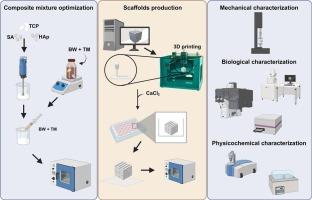蜂蜡富集磷酸三钙/羟基磷灰石/海藻酸钠/百里香酚3d打印支架在骨组织工程中的应用
IF 6
2区 医学
Q2 MATERIALS SCIENCE, BIOMATERIALS
Materials Science & Engineering C-Materials for Biological Applications
Pub Date : 2025-08-05
DOI:10.1016/j.bioadv.2025.214440
引用次数: 0
摘要
组织工程,特别是骨组织工程(BTE),继续对现代医学构成重大挑战。在这项工作中,探索了使用Fab@Home 3D绘图仪挤出机创建3D支架的快速原型技术。为此,配制了一种新型的由磷酸三钙(TCP)、羟基磷灰石(HAp)、海藻酸钠(SA)、蜂蜡(BW)和百里香酚(TM)组成的复合混合物。BW和TM使3D支架具有更粗糙的表面和适度的亲水性,这些特性对于介导细胞粘附和增殖至关重要。此外,含有BW的3D支架的抗压强度和杨氏模量显著增加,与小梁骨相当。TM加载阻止了金黄色葡萄球菌和大肠杆菌感染的建立,抑制了细菌在支架表面的粘附和增殖。此外,在21天的时间里,支架的细胞相容性得到证实,支架表面出现了人成骨细胞(hOB)的粘附和增殖。同时,钙和磷酸盐离子在支架表面积聚,形成磷灰石晶体。因此,这种改进的复合混合物在BTE中的应用显示出良好的结果,不仅促进了hOB细胞的粘附和增殖,而且避免了细菌感染,解决了基于植入物治疗的关键挑战。本文章由计算机程序翻译,如有差异,请以英文原文为准。

Beeswax-enriched tricalcium phosphate/hydroxyapatite/sodium alginate/thymol 3D-printed scaffolds for application in bone tissue engineering
Tissue engineering, particularly bone tissue engineering (BTE), continues to pose significant challenges to modern medicine. In this work, a rapid prototyping technique was explored to create 3D scaffolds using a Fab@Home 3D-Plotter extruder. For that purpose, a novel composite mixture containing tricalcium phosphate (TCP), hydroxyapatite (HAp), sodium alginate (SA), beeswax (BW), and thymol (TM) was formulated. BW and TM resulted in 3D scaffolds with rougher surfaces and moderate hydrophilic profiles, properties crucial for mediating cell adhesion and proliferation. Moreover, the 3D scaffolds containing BW displayed a significant increase in compressive strength and Young modulus, being comparable to those exhibited by trabecular bone. TM loading prevented the establishment of Staphylococcus aureus and Escherichia coli infections, inhibiting bacterial adhesion and proliferation at the scaffolds' surface. Additionally, the cytocompatibility of the scaffolds was confirmed over 21 days, with the adhesion and proliferation of Human osteoblasts (hOB) at the scaffold's surfaces. Simultaneously, calcium and phosphate ions accumulated at the scaffolds' surface, forming apatite crystals. Therefore, this improved composite mixture showed promising results for being applied in BTE, not only facilitating hOB cell adhesion and proliferation but also avoiding bacterial infection, addressing a critical challenge in implant-based therapies.
求助全文
通过发布文献求助,成功后即可免费获取论文全文。
去求助
来源期刊
CiteScore
17.80
自引率
0.00%
发文量
501
审稿时长
27 days
期刊介绍:
Biomaterials Advances, previously known as Materials Science and Engineering: C-Materials for Biological Applications (P-ISSN: 0928-4931, E-ISSN: 1873-0191). Includes topics at the interface of the biomedical sciences and materials engineering. These topics include:
• Bioinspired and biomimetic materials for medical applications
• Materials of biological origin for medical applications
• Materials for "active" medical applications
• Self-assembling and self-healing materials for medical applications
• "Smart" (i.e., stimulus-response) materials for medical applications
• Ceramic, metallic, polymeric, and composite materials for medical applications
• Materials for in vivo sensing
• Materials for in vivo imaging
• Materials for delivery of pharmacologic agents and vaccines
• Novel approaches for characterizing and modeling materials for medical applications
Manuscripts on biological topics without a materials science component, or manuscripts on materials science without biological applications, will not be considered for publication in Materials Science and Engineering C. New submissions are first assessed for language, scope and originality (plagiarism check) and can be desk rejected before review if they need English language improvements, are out of scope or present excessive duplication with published sources.
Biomaterials Advances sits within Elsevier''s biomaterials science portfolio alongside Biomaterials, Materials Today Bio and Biomaterials and Biosystems. As part of the broader Materials Today family, Biomaterials Advances offers authors rigorous peer review, rapid decisions, and high visibility. We look forward to receiving your submissions!

 求助内容:
求助内容: 应助结果提醒方式:
应助结果提醒方式:


